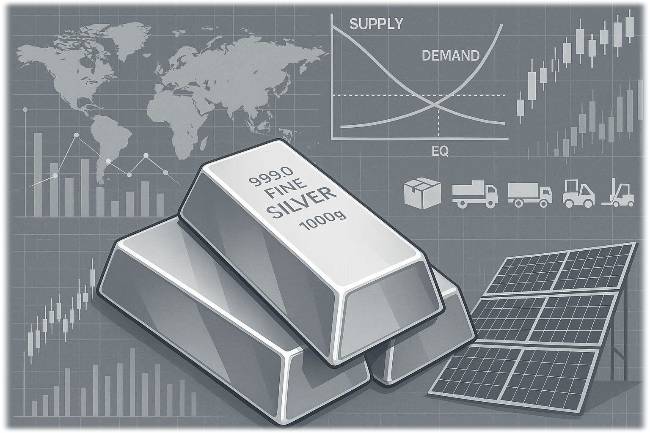Rising Silver Prices Reflect Global Supply-Demand Imbalance
Disclaimer: This article is for informational purposes only and does not constitute financial, investment, or legal advice. Readers should conduct their own research or consult professionals before making decisions.
By Doug Young – 16 October 2025
Introduction
Silver prices have surged significantly in 2025, driven by a complex interplay of structural supply deficits, heightened industrial demand, and logistical challenges in physical silver distribution.
This news item aims to provide a clear, fact-based overview of the factors shaping today’s silver market. Understanding these fundamentals is crucial given silver’s unique role as both an industrial metal and an investment asset.
Silver Supply and Demand Fundamentals
Global Silver Demand
Silver serves a diverse range of uses, with industrial applications accounting for approximately 59% of total consumption as of 2025.
Key industrial sectors include solar photovoltaics (PV), electronics, electric vehicles (EVs), medical devices, and consumer electronics. The solar industry alone has seen a rapid increase in silver consumption, with demand growing annually by over 12%, and China expanding its solar capacity by 45% in 2024.
Investment demand also exerts strong influence, particularly through silver-backed exchange-traded products (ETPs) and coins. In the first half of 2025, global silver-backed ETPs recorded net inflows of about 95 million ounces, reducing the mobile silver supply accessible for industrial use.
Silver Supply Constraints
On the supply side, silver mining remains constrained. Notably, only about 30% of global silver production comes from primary silver mines; the majority is recovered as a byproduct of mining for other metals like gold, copper, lead, and zinc. This production structure limits the ability of supply to quickly respond to price signals.
Meanwhile, the silver market has been in a structural deficit every year since 2021, with the cumulative shortfall between supply and demand nearing 800 million ounces. Factors such as chronic underinvestment in new mining projects, declining ore grades, increasing production costs, and environmental regulations have further restricted production growth.
Recent Market Conditions Driving Price Rises
Physical Market Strain
The silver market is currently experiencing backwardation, an unusual condition where spot prices exceed futures prices. This premium on immediate delivery signals a tight physical market.
Concurrently, lease rates—the cost to borrow silver—have surged in London, reflecting a queue of investors seeking physical metal. Bid-ask spreads have widened, indicating higher uncertainty and risk premiums among market makers.
Logistical Challenges and Arbitrage
Physical silver bars are heavy and costly to move. The combination of robust demand and localized shortages, particularly in London vault inventories, has led to increased use of airfreight to transport silver bars between New York and London.
Though more expensive than shipping, airfreight arbitrage becomes economical when speed commands a premium, showing that supply chain logistics are under pressure rather than broken.
Understanding Market Mechanics
Backwardation Explained
Backwardation differs from the more common contango market structure, where futures trade above spot prices.
In silver’s case, a premium on immediate delivery reflects strong demand relative to short-term supply availability. This price structure expresses convenience and immediacy value, highlighting that buyers place extra importance on receiving physical silver now rather than later.
Paper vs Physical Silver
While futures contracts and ETPs facilitate price discovery and liquidity, they do not always represent immediate physical delivery.
Investment in vault-backed silver effectively locks up physical supply, reducing metal availability for industrial users and contributing to market tightness.
Impact of Industrial and Investment Demand Changes
Growth of Solar and Electronics Sectors
The expansion of clean energy technologies such as solar panels and electric vehicles critically depends on silver’s superior conductivity and antimicrobial properties.
Although advances in manufacturing have reduced silver content per unit, overall demand continues to grow as the industries themselves expand.
Investment Demand Trends
Economic uncertainty and inflation concerns have driven increased allocation to silver ETPs and physical coin purchases, further tightening available inventories.
Investor behavior plays a pivotal role in supply-demand dynamics, particularly when industrial and retail demands coincide.
Regional Market Highlights
India’s Festive Season Demand Surge
India, one of the world’s largest silver consumers, experiences seasonal spikes especially around festive periods. This demand drives regional premiums and can divert silver supply from global hubs like London and New York, exacerbating local shortages and price differentials.
China’s Solar Capacity Expansion
China’s significant solar installation growth bolsters silver demand, accounting for a notable share of global consumption. This trend underlines the importance of industrial applications in shaping silver’s supply-demand balance.
Outlook and Market Signals
Key indicators to monitor include lease rates, spot-futures spreads, physical inventories, and ETF inflows.
Persistent backwardation and high borrowing costs suggest ongoing physical market stress. Volatility is likely to continue as structural deficits and demand growth outpace supply responses.
Investors and market participants should focus on these empirical indicators to gauge market health without conflating observation with investment advice.
Conclusion
The sharp rise in silver prices throughout 2025 results from fundamental and structural imbalances: sustained supply deficits, rising industrial demand from burgeoning technologies, and logistical constraints affecting metal distribution.
Rather than market manipulation or collapse, these trends reflect a repricing of silver’s value in light of global economic realities. Maintaining awareness of these factors supports informed engagement with the silver market as it navigates ongoing challenges and opportunities.
Disclaimer: This article is for informational purposes only and does not constitute financial, investment, or legal advice. Readers should conduct their own research or consult professionals before making decisions.









